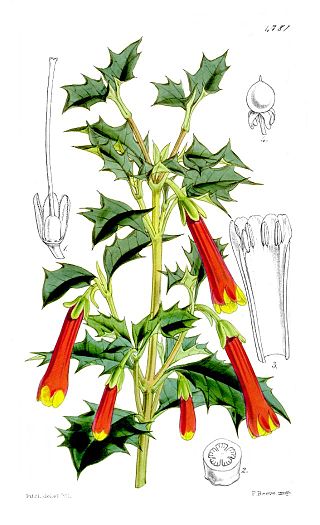Related Research Articles

Desfontainia is a genus of flowering plants in the family Columelliaceae, though it was placed formerly in Loganiaceae, Potaliaceae, or a family of its own, Desfontainiaceae.

Cucurbitacins are a class of biochemical compounds that some plants – notably members of the pumpkin and gourd family, Cucurbitaceae – produce and which function as a defense against herbivores. Cucurbitacins and their derivatives have also been found in many other plant families, in some mushrooms and even in some marine mollusks.
Goyaglycoside is any of several related triterpenoid glycosides found in the fruits bitter melon vine, called goya in Okinawan language. They include:

Balsaminapentaol or cucurbita-5,25-diene-3β,7β,23(R),24(R),29-pentaol, is a chemical compound with formula C
30H
50O
5, found in the Balsam apple vine. It is a cucurbitane-type triterpenoid, related to cucurbitacin, isolated by C. Ramalhete and others in 2009.

Balsaminol A or cucurbita-5,24-diene-3β,7β,23(R),29-tetraol, is a chemical compound with formula C
30H
50O
4, found in the Balsam apple vine. It is a cucurbitane-type triterpenoid, related to cucurbitacin, isolated by C. Ramalhete and others in 2009.

Balsaminol B or 7β-methoxycucurbita-5,24-diene-3β,23(R),29-triol, is a chemical compound with formula C
31H
52O
4, found in the balsam apple vine. It is a cucurbitane-type triterpenoid, related to cucurbitacin, isolated by C. Ramalhete and others in 2009.

Cucurbalsaminol A or cucurbita-5,23(E)-diene-3β,12β,25-triol, is a chemical compound with formula C
30H
50O
4, found in the Balsam apple vine. It is a cucurbitane-type triterpenoid, related to cucurbitacin, isolated by C. Ramalhete and others in 2009.

Cucurbalsaminol B or 7β-methoxycucurbita-5,23(E)-diene-3β,12β,25-triol, is a chemical compound with formula C
31H
52O
4, found in the Balsam apple vine. It is a cucurbitane-type triterpenoid, related to cucurbitacin, isolated by C. Ramalhete and others in 2009.

Karavilagenin E is a chemical compound found in the Balsam apple vine. It is a cucurbitane-type triterpenoid, related to cucurbitacin.

Cucurbitane is a class of tetracyclic chemical compounds with formula C
30H
54. It is a polycyclic hydrocarbon, specifically triterpene. It is also an isomer of lanostane, from which it differs by the formal shift of a methyl group from the 10 to the 9β position in the standard steroid numbering scheme.
A kuguaglycoside is one of several chemical compounds isolated from the roots of the bitter melon vine by J.-C. Chen and others.
A kuguacin is one of several chemical compounds isolated from the bitter melon vine by J.-C. Chen and others.
A momordicine is any of several compounds found in the bitter melon vine, Momordica charantia. They are glycosides of cucurbitane derivatives. They include
Endecaphyllacin is either of two similar compounds found in certain plants, such as Hemsleya endecaphylla.
Hemslecin is any of several compounds obtained from plants of the genus Hemsleya, which are used in Asian folk medicine. They are triterpene derivatives, specifically with the cucurbitane skeleton, related to cucurbitacin F.
Perseapicroside is any one of several chemical compounds isolated from certain plants, notably Persea mexicana. They can be seen as derivatives of the triterpene hydrocarbon cucurbitane, more specifically from cucurbitacin F.
Scandenoside is any one of several chemical compounds isolated from certain plants, notably Hemsleya panacis-scandens. They can be seen as derivatives of the triterpene hydrocarbon cucurbitane, more specifically from cucurbitacin F.
Datiscoside is any one of several chemical compounds isolated from certain plants, notably Datisca glomerata. They can be seen as derivatives of the triterpene hydrocarbon cucurbitane, more specifically from cucurbitacin F.
Khekadaengoside is any one of several chemical compounds isolated from certain plants, notably Trichosanthes tricuspidata. They can be seen as derivatives of the triterpene hydrocarbon cucurbitane, more specifically from cucurbitacins H and L.
Brydioside is any one of several chemical compounds isolated from certain plants, notably Bryonia dioica. They can be seen as derivatives of the triterpene hydrocarbon cucurbitane, more specifically from cucurbitacin Lor 23,24-dihydrocucurbitacin I.
References
- 1 2 3 Jian Chao Chen, Ming Hua Chiu, Rui Lin Nie, Geoffrey A. Cordell and Samuel X. Qiu (2005), "Cucurbitacins and cucurbitane glycosides: structures and biological activities" Natural Product Reports, volume 22, pages 386-399 doi : 10.1039/B418841C